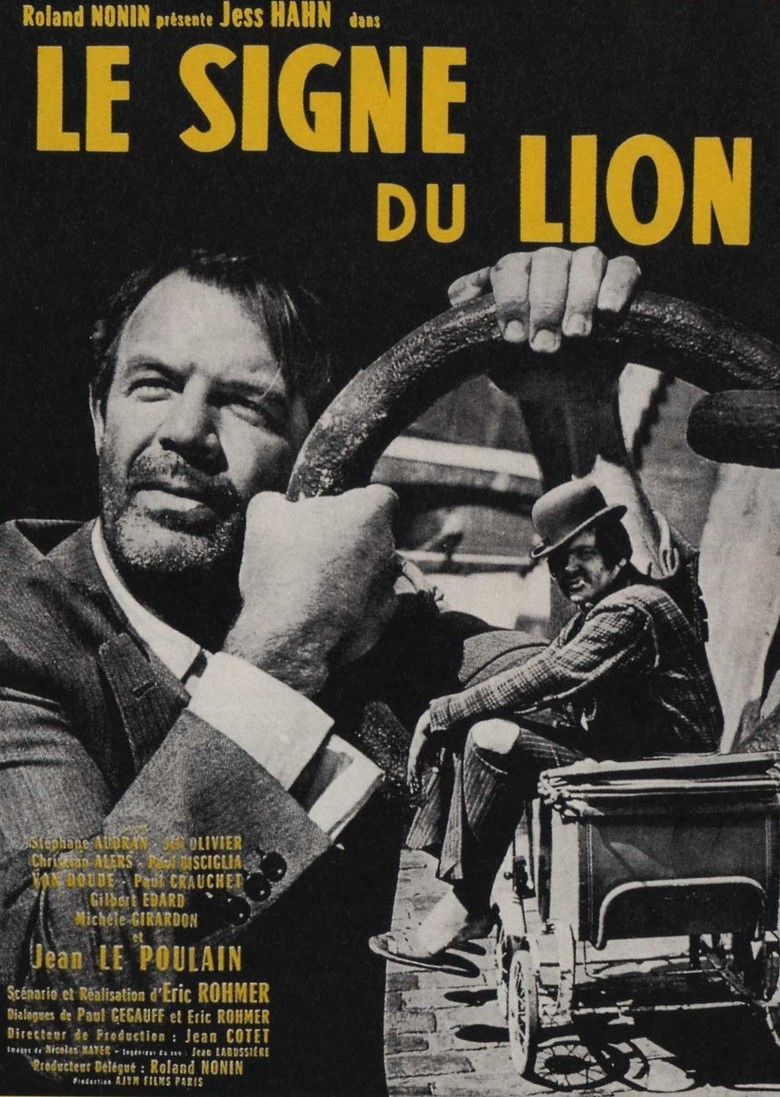Le Signe du Lion
7.6 /10 1 Votes
Director Eric Rohmer Country France | 7.4/10 IMDb Duration Language French | |||||||||||||||||||||||||||||||||
 | ||||||||||||||||||||||||||||||||||
Release date 2 May 1962 (1962-05-02) (France) Writer Paul Gegauff (dialogue), Eric Rohmer | ||||||||||||||||||||||||||||||||||
The sign of leo le signe du lion 1962 french trailer
Le Signe du lion (The Sign of Leo) is a French film directed by Eric Rohmer, his feature debut; although filmed in the summer of 1959, it was first released in France in May 1962. Along with Le Beau Serge, directed by Claude Chabrol (who produced The Sign of Leo), it was one of the first films of the French New Wave. The title refers to the Zodiac sign Leo, under which the protagonist says he was born. Much of the films plot is concerned with notions of luck and fate. The film was not a commercial success and Rohmer didnt make another feature for 8 years, instead concentrating on short films and his position at the influential film magazine Cahiers du cinema.
Contents
- The sign of leo le signe du lion 1962 french trailer
- Plot
- Production
- Style
- Reception and Influence
- References
It stars Jess Hahn, Michele Girardon, and Van Doude.
n American in Paris lives by sponging off his working friends, and throws a party using borrowed money when his rich American aunt dies, believing firmly in his horoscope.
Plot
Pierre (Jess Hahn) is an American-born, 39-year-old bohemian and aspiring composer living in Paris. One morning he receives a telegram informing him that his wealthy aunt has died. Assuming that he has inherited her factories in Germany and Switzerland, he throws a lavish party with his friend Jean-Francois (Van Doude), a reporter for Paris-Match. Pierre borrows large sums of money, believing that hell be able to pay everyone back with his inheritance; however, he soon discovers that his aunt left everything to his cousin. Penniless and abandoned by his friends, he soon finds himself homeless.
Production
The film was photographed in black and white by Nicholas Hayer and printed at Laboratoires GTC in Joinville-le-Pont. Most of the shooting, including all outdoor scenes, was done on location. Rohmer, the eldest of the members of the Cahiers du cinema circle of the Nouvelle Vague, was 38 at the time of production.
The film was produced by fellow New Wave director and Cahiers du cinema critic Claude Chabrol through Ajym Films, which had produced his debut feature, Le Beau Serge and would go on to produce Paris nous appartient, the debut feature of their colleague and friend Jacques Rivette.
Style
The film is often noted for the differences in tone and cinematic style it has from the work Rohmer is best known for. The film is shot in a wider aspect ratio, 1.66, than most of Rohmers features; the director has used the 1.37 aspect ratio (also known as Academy ratio) for almost all of his films. It also features a musical score (rare for Rohmer) by Louis Saguer and a cameo by fellow New Wave director and Cahiers du cinema critic Jean-Luc Godard; though the other French New Wave directors frequently appeared in cameo roles in each others films (or, as in the case of Godard, cast directors they admired in their films), this is the only instance of such casting in a feature film directed by Rohmer. Writing for the website kamera.co.uk, Chris Weigand notes that in The Sign of Leo "perhaps more than in any other New Wave work," Paris appears to be "a filthy and unattractive city, viewed through the eyes of the desperate and needy."
Also unlike most of the directors films, Rohmer did not write the dialogue for the screenplay. The work is credited to Paul Gegauff, and Rohmer is instead only credited with the films story.
Reception and Influence
Though praised by other members of the Nouvelle Vague (including Jean-Luc Godard, who put it on his top ten for 1962, The Sign of Leo was a commercial failure, a fact that kept Rohmer from making another feature until 1966.
The film is one of Rohmers least-seen features in the Anglosphere; it did not screen in the UK until 1966, and didnt show until 1970 in the United States, where it has never been available on home video (an English-subtitled DVD is available in the UK). Because of this, critical writing on the film is relatively scarce. Writing for the British film website kamera.co.uk, Chris Weigand notes that "the film is littered with painful moments" and that "with its depiction of one mans long physical and spiritual decline, Le Signe Du Lion recalls the great naturalist novels of Emile Zola as well as the works of American realists such as Theodore Dreiser. It marks Rohmer out as one of the most literary of New Wave directors - always devoting particular attention to his characters complex emotions and inner thoughts."
The film influenced German director Rainer Werner Fassbinder, who paid homage to it with his first short film, Der Stadtstreicher.
References
Le Signe du Lion WikipediaLe Signe du Lion IMDb Le Signe du Lion themoviedb.org
